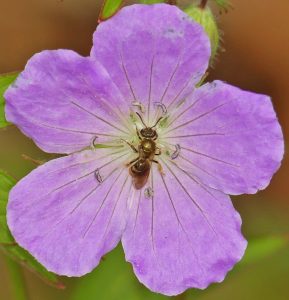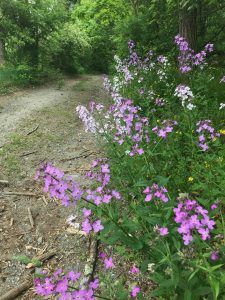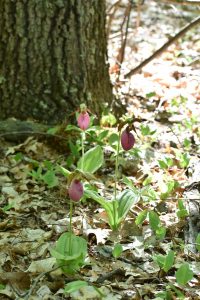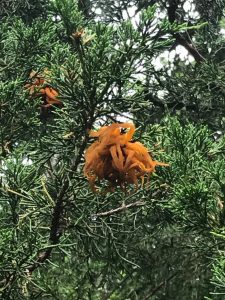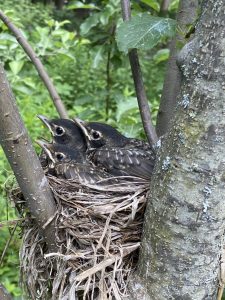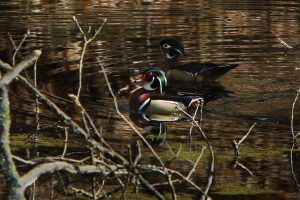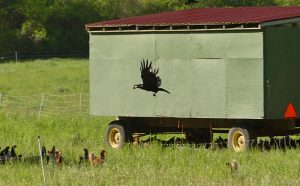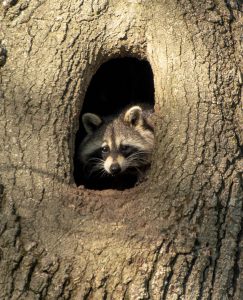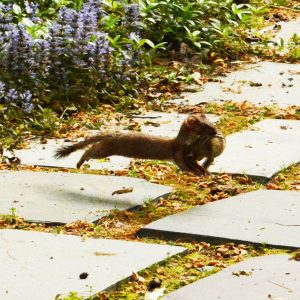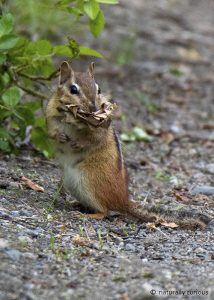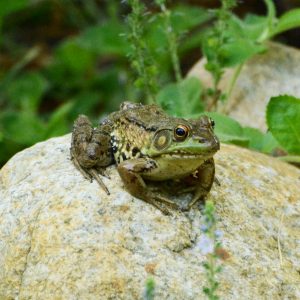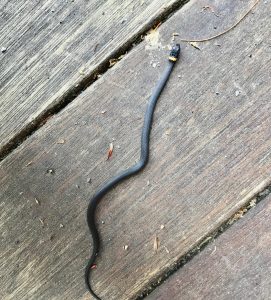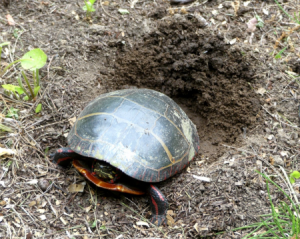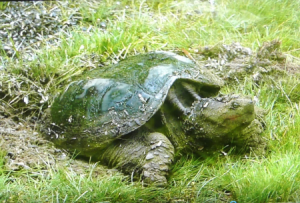Written by Gwyn Loud for the Lincoln Land Conservation Trust. She welcomes your sightings and questions at 781-259-8690 or gwynloud555@gmail.com.
Summer arrives officially on June 20, the solstice, but we have already had a taste of the new season with hot days in the 80s at the end of May. These were followed, however, by a dip to high thirties the last day of the month. May was very dry, with rainfall much below normal. June’s rainfall is still low, in spite of a few brief downpours. According to NOAA, the 25 days between May 17th and June 10th have been the driest for this period in over 100 years. Gardens and farms need a good steady rain.
Lady’s slippers bloomed in abundance this year and one observer noted many ruby-colored flowers in addition to the usual pink ones. One of my neighbors had a jack-in-the pulpit nearly three feet high. Along roadsides one can find Dame’s rocket, a garden escapee, and wild geranium, as well as celandine, with its yellow flowers. Maple-leaved viburnum, a shrub, is blossoming now in the woods, and multiflora rose (invasive) is flowering and fragrant. Is it my imagination that poison ivy is more prolific than ever this year? Lawns are carpeted with dandelions, buttercups, and yellow hawkweed. Horse chestnut trees and black chokecherries are nearly finished blooming, and now some, but not all, black locusts are flowering.
This is the time when pollen, especially from pines, covers every surface indoors and out. After one of the recent thunderstorms, if you looked at a cedar tree you might have seen the orange fleshy growths produced by cedar-apple rust. This fungus only appears after rain and requires two hosts within a mile of each other: a cedar or juniper and an apple, quince, or crabapple tree.
Bird song is gradually diminishing now that mating pairs and territories are well established but you may hear the peeping of baby birds in nests or the begging calls of fledglings. Observers have been watching nesting birds such as bluebirds, chickadees, Carolina wrens, house wrens, tree swallows, barn swallows, house finches, and robins and some of these are now raising second broods. An Old Concord Road resident has had bluebirds using the same box for twenty-one years! Not all nests are successful; predators such as raccoons, snakes, and chipmunks may take eggs, birds such as house wrens may puncture eggs and remove them, or house sparrows might even kill a brooding bird. Crows or jays may snatch nestlings. It is likely that ravens nested in Lincoln this year, perhaps for the first time. A raven was photographed plucking chicken eggs from the CCF flock in the Codman South field and about a week later noisy young ravens were being fed by parents in woods near Farm Meadow. A pair of red-tailed hawks raised two young in a nest high in a pine on Beaver Pond Road. Reports from Drumlin Farm include a killdeer with four chicks in Boyce Field and a wild turkey with nine poults. I was startled to see a female wood duck leading a parade of eight tiny ducklings across my lawn. Where did they come from, and where were they going? The closest pond is a long way off.
Other avian species of interest seen recently include a solitary sandpiper in a wet patch in Browning Field North, and an orchard oriole in the same area. A common loon was calling from the Cambridge Reservoir and a sora was heard in the marsh behind St. Anne’s, a location where four great blue herons were seen together. A Farrar Pond abutter added rough-winged swallows to his “yard list” and two uncommon warblers, a Wilson’s and a hooded (click here to listen to an audio recording of a Hooded Warbler by Norman Levey) have been reported. A birder was excited to witness an aerial display by ruby-throated hummingbirds as they swooped and whirred in big loops near his feeder for over twenty minutes. Scarlet tanagers can be heard singing from the woodland canopy, their song often described as “like a robin’s with a sore throat”. Other woodland birds to listen for are the ovenbird, saying “teacher, teacher, TEACHER”, a wood thrush singing its musical “ee-o-lay-”, or the great crested flycatcher, giving its nasal ascending “wheeep” call.
Our local mammals have been busy raising families. A mother muskrat and babies were seen in the DeNormandie Pond by Trapelo Road, kayakers spotted a baby beaver in Valley Pond, and a weasel raised young in a stone wall near Farrar Pond. Close to Twin Ponds a walker saw, “three baby fishers gamboling until their mother appeared and they quickly and quietly filed off behind her. The baby fishers looked like little fluffy Rikki Tikki Tavis, so cute. Mum looked pretty serious however, as if they were faintly embarrassing to her in their boisterousness.”
Many raccoons and red foxes have been reported, as well as woodchucks, one even climbing a crabapple tree! I often hear coyotes howling at night. Chipmunks and gray squirrels seem more numerous than ever this summer, perhaps due to the mast last fall, providing a plentitude of acorns and other nuts. Naturalist Mary Holland writes on her blog about chipmunks: “Eastern Chipmunks breed twice a year, typically in March/April and in June/July. After mating, the female chipmunk outfits a central nesting chamber deep within the ground with leaves. She will give birth to four to six young in about a month. When born the young are about the size of a jelly bean, toothless and furless with closed eyes and ears. The mother raises her young by herself and by the time they are a month old, they begin to emerge from their burrow. At this point they are about two-thirds the size of an adult chipmunk”.
Gray tree frogs have been calling and we can now hear the deep “jug-a- rum” calls of bullfrogs. Their huge tadpoles take two years to become adults. If you want to hear green frogs giving their “glunk” calls, stop by the pond, now filling in with cattails, next to Pierce House. There have been many sightings of snakes, most often garter snakes, and I found a baby ring-necked snake, only five inches long, on my deck. An observer described, “a veritable tribe of water snakes in the lowlands between Bedford Road and Flints Pond, along the gas line.”
Gray Tree Frog recording by Michelle Barnes:
This is the season when turtles are laying eggs, leaving ponds to find soft sandy ground. If you see one on the road, please protect it from cars or move it carefully to the side in the direction in which it is headed. Do not get near a snapping turtle’s head!
As for insects, they are very active now that hotter weather has arrived. I have seen a number of butterflies; monarchs have reached New England and will be laying their eggs on milkweed. Bees of various species are especially noteworthy, given the widespread interest in pollinators and plants which attract them. Spring crickets have been singing on warm evenings. As Norm Levey explains, “they overwintered as nymphs rather than eggs so have a huge head start on adulthood. “We should be watching for fireflies too. Sara Lewis, former Lincoln resident and a world expert on fireflies, continues to have graduate students doing studies in Smith-Andover Field on how artificial light impacts fireflies. They have seen four species in that location so far. Sara writes that July 4-5 is World Firefly Day 2020 (virtual this year) and includes links to two publications here and here. which focus on firefly conservation and things we can all do to help them survive hurdles such as habitat loss, pesticides, light pollution, and climate change.
July 4 will also be aphelion, the day that Earth is farthest from the sun in its orbit. This always seems counterintuitive until we remember that the Earth’s tilt towards the sun is what gives us our warm summer. Another astronomy note: the sun is at a very low period in its eleven-year cycle of sunspots, the lowest in almost 200 years.
© Gwyn Loud


